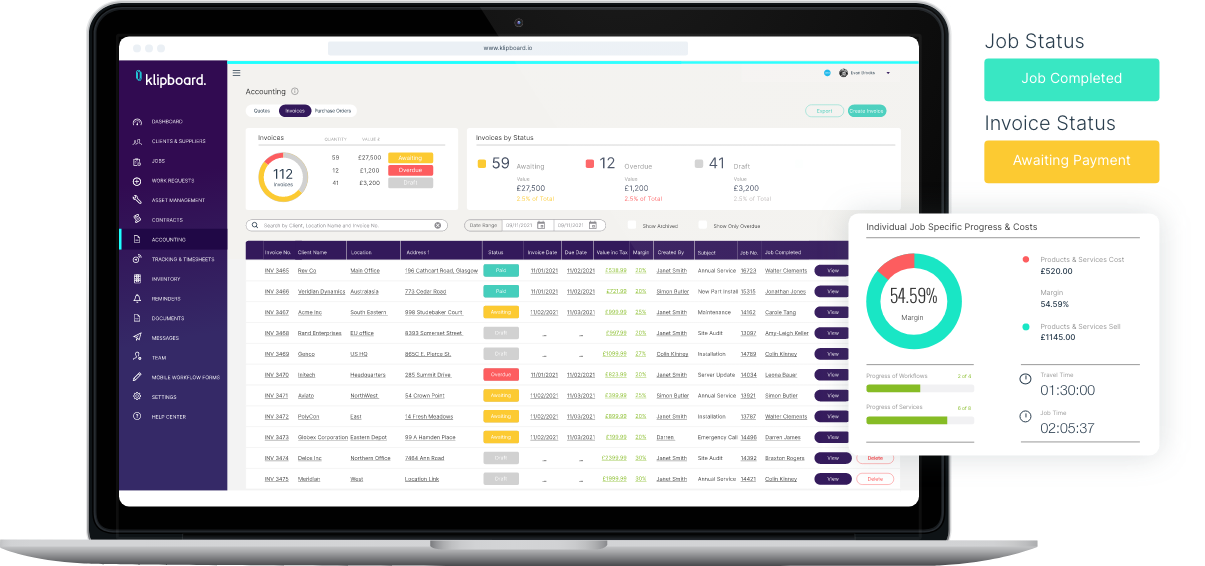Are you tired of chasing overdue invoices or drowning in a sea of spreadsheets and paperwork to manage your plumbing business finances effectively? To maintain profitability, a robust invoicing process and strategic estimating are essential. Plumbing invoicing shares common ground with various field services, where your field team assesses the required work, an estimate is agreed upon with the customer, and, upon job completion, an invoice is issued for payment. If this process isn’t seamless, it can lead to cash flow challenges, impacting your bottom line.
Understanding Plumbing Invoicing
To ensure your plumbing business doesn’t suffer due to an inadequate invoicing strategy, it’s essential to recognize the critical role an invoice plays. It serves as a crucial document, informing the customer of the total amount due while providing itemized details of materials used and outlining payment terms and conditions. Whether you employ a plumbing invoicing template or create one from scratch, clarity, precision, and ease of understanding are paramount.
Certain key elements should never be omitted from an invoice. These include a breakdown of labor and materials, the customer’s address, your business information (including relevant registrations and tax details), an invoice number, the final costs, and available payment methods. Beyond this basic model, you may also want to consider incorporating photos of completed work or specifying due dates for payment.
Is your plumbing business ready to make a splash in the invoicing arena?
Here are some invaluable insights to enhance your plumbing invoicing strategy:
- Digital Invoicing Efficiency: Wave goodbye to paper invoices and embrace digital invoicing. Streamline the process, reduce errors, and save on printing costs by using digital invoicing software. Consider platforms like QuickBooks, FreshBooks, or Xero for seamless invoicing.
- Detailed Line Items: Be crystal clear about your services. Break down your invoice into detailed line items, listing each plumbing task separately. Transparency in pricing builds trust with your clients and helps them understand the value they receive.
- Accurate Time Tracking: Utilize time tracking tools to monitor the hours spent on each plumbing project. This not only ensures accurate billing but also aids in future project planning and resource allocation.
- Embrace Mobile Solutions: Leverage mobile invoicing apps to create invoices on-site. This not only impresses your clients with promptness but also reduces administrative overhead. Apps like Zoho Invoice and Invoice2go offer mobile solutions.
- Automated Reminders: Set up automated reminders for invoice due dates. Many invoicing software options provide this feature, ensuring that clients pay on time and reducing the need for follow-up calls.
- Online Payment Options: Simplify the payment process by offering online payment options. Include payment gateways like PayPal or Stripe on your invoices to make it convenient for clients to settle their bills.
- Professional Templates: Design professional-looking invoice templates that reflect your plumbing business’s brand. Use your logo, colors, and a clean layout to convey a sense of professionalism.
- Itemized Expenses: Include itemized expenses beyond labor costs. This could involve listing materials used or any additional charges. Transparency helps clients understand the full scope of their plumbing project.
- Tax Compliance: Ensure that your invoices adhere to tax regulations in your area. This includes correctly applying sales tax or VAT and providing the necessary tax identification numbers.
- Customer Communication: Establish open lines of communication with your clients regarding invoices. Address any concerns promptly, and be prepared to explain any charges in detail.
- Integration with Accounting Software: Choose invoicing software that integrates seamlessly with your accounting software. This simplifies the financial management aspect of your plumbing business.
- Client Portal Access: Consider platforms that offer client portal access. This allows clients to view their invoices, payment history, and project details online, enhancing their overall experience.
- Regular Review: Periodically review your invoicing process for efficiency. Identify bottlenecks or areas for improvement and adjust your strategy accordingly.
- Legal Compliance: Stay informed about any legal requirements for plumbing invoicing in your region. Compliance is crucial to avoiding potential legal issues.
- Feedback Collection: Encourage client feedback on your invoicing process. Use their input to fine-tune your strategy and enhance client satisfaction.
Revamping your plumbing invoicing strategy with these tips can help you provide exceptional service to your clients while optimizing your business operations.

Top Plumbing Invoicing and Estimating Software Options
Technology has transformed the plumbing industry, offering a plethora of software options to streamline estimating and invoicing processes. Here are some top software recommendations:
1. Klipboard: This comprehensive cloud-based platform simplifies job management, enabling you to break down labor and material costs swiftly. Klipboard allows you to create custom plumbing invoice templates, accessible to your field staff via the mobile app for immediate invoicing. It also offers flexible payment options, enhancing the overall invoicing process.
2. Simpro: Ideal for plumbing businesses, Simpro offers not only invoicing capabilities but also online booking, dispatching, and real-time client communication. The platform boasts robust reporting and analytics to provide deep insights into business performance.
3. Jobber: With features like online booking, scheduling, and invoicing, Jobber is a practical choice for plumbing businesses. Its mobile app empowers plumbers to manage their business on the go, making it a versatile solution for fieldwork.
Effective Tips for Accurate Plumbing Invoicing
Achieving accurate plumbing invoicing requires efficient practices. Consider implementing these strategies:
1. Utilize Invoice Templates: Streamline the invoicing process for your team by creating standardized plumbing invoice templates. This approach saves time and ensures consistency in your invoicing documents.
2. Adapt to Scope Changes: When customer requests result in changes to the scope of work, document these modifications promptly. Flexibility in your invoicing process is crucial for accommodating such adjustments.
3. Maintain Customer Preferences: Keep records of customer payment preferences, contact methods, and recent work history. This not only expedites payments but also strengthens customer relationships.
4. Implement Invoice Tracking: Manage your invoices and payments efficiently by employing software that centralizes your quotes, jobs, and invoices. This tracking system helps avoid confusion.
Frequently Asked Questions (FAQs)
Even experienced plumbing professionals have questions regarding plumbing invoicing. Here are answers to some common queries:
1. What information should be included in a plumbing invoice?
Essential information to include in a plumbing invoice comprises your plumbing company’s contact details, itemized lists of labor and materials, the work location, invoice date, completion date, total amount due, payment methods, payment terms, and signature areas for both parties’ agreement.
2. How often should I invoice my clients?
While monthly invoices are standard in business, the plumbing industry’s approach may differ. For residential work, invoices are often issued upon project completion. For commercial projects, you may invoice after completing specific project stages.
3. How can I track my invoices and payments?
Comprehensive plumbing invoicing software simplifies simultaneous invoice and payment tracking. It replaces the need for paper-based spreadsheets, providing increased visibility into job progress. You can generate reports and schedules to monitor outstanding and paid invoices.
4. Is it crucial to provide itemized invoices?
Yes, itemized invoices are essential. They demonstrate transparency, revealing what the customer pays for, including materials and services. This fosters trust and eliminates ambiguity between initial estimates and final costs.
Summary
Once you’ve honed your plumbing estimating and invoicing processes, you can confidently drive revenue to your business while ensuring fair compensation for your services. Additionally, charging reasonable rates is essential to maintaining a thriving plumbing enterprise.


